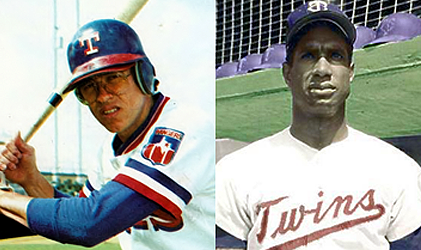 MICHAEL: Today we received an email from a reader who wanted to know the meaning behind the expression “The Mendoza Line.” You may have heard Eric or I use this term during the course of a radio interview as it is a standard phrase for those of us who dwell in the annals of major league mediocrity. There are actually two-theories as to the origins of this term…
MICHAEL: Today we received an email from a reader who wanted to know the meaning behind the expression “The Mendoza Line.” You may have heard Eric or I use this term during the course of a radio interview as it is a standard phrase for those of us who dwell in the annals of major league mediocrity. There are actually two-theories as to the origins of this term…
According to the most widely accepted definition The Mendoza Line is: “…derived from the name of shortstop Mario Mendoza, whose lifetime batting average is taken to define the threshold of incompetent hitting. Even though Mendoza’s career batting average over nine seasons (1974–1982) was .215, most often the cutoff point is said to be .200, and, when a position player’s batting average falls below that level, the player is said to be below the ‘Mendoza Line.’ This is often thought of as the offensive threshold below which a player’s presence in Major League Baseball cannot be justified, regardless of his defensive abilities. Pitchers are not held to this standard, since their specialized work and infrequent batting requires less hitting competence. The expression has been also extended to other realms to indicate a low-end cut-off point.” (Source: wikipedia)
Mario Mendoza was a defensively-gifted player from Chihuahua, Mexico who played for the Pittsburgh Pirates, Seattle Mariners, and Texas Rangers. Despite having a strong fielding presence, he consistently struggled at the plate and was known as a sub-.200 hitter whose average frequently fell into the .180 to .190 range during any particular year. The term “The Mendoza Line” allegedly started out in 1979 as a clubhouse joke started by teammates Tom Paciorek and Bruce Bochte. According to Mendoza, “They were giving George Brett a hard time because he had a slow start that year, so they told him, ‘Hey, man, you’re going to sink down below the Mendoza Line if you’re not careful.’” ESPN commentator Chris Berman and Brett himself are said to have been at the forefront of spreading the phrase (although both deflect the credit for popularizing the term). Berman routinely used it on Sportscenter to describe someone who was struggling with the offensive-side of their game.
Mexican sportscaster Oscar Soria corroborates this story. The voice of the Mexican League’s Hermosillo Naranjeros, Soria provided these comments concerning the Mendoza Line. He stated, “I know Mario because he is the manager of the Obregon Yaquis in the Mexican Pacific League. I am a sportscaster in this league, I do the play-by-play of the Hermosillo team on TV, and that’s the reason I know Mario very well. In an interview a few weeks ago, I asked Mario about the Mendoza line and he said that Tom Paciorek was the first to mention the phrase ‘Mendoza Line’ when he read the Sunday paper. Then George Brett heard about that and, years after that, Chris Berman quoted about the Mendoza line. Mario said that when Chris Berman mentioned it and people started to laugh, he was angry, but now he enjoys the fame of the phrase Mendoza line.”
It should be added that on the defensive side of the ball, Mario Mendoza’s career .961 fielding percentage is one of the 100 best ever for a shortstop (minimum 500 games played). Baseball historian Al Pepper reminds us all to look at Mario Mendoza’s contributions in context at the risk of nullifying the positive parts of his legacy. He writes, “In the final analysis, Mario Mendoza batting statistics may not support the claim that he was an asset to a team. But consider this. In his five years with Pittsburgh, the Pirates were a division champion twice and division runner-up three times. Prior to Mario’s trade to Seattle in 1979, the Mariners finished 56-104; with Mendoza as the everyday shortstop, the Mariners improved to 67-95 and out of the AL West cellar. When he arrived in Texas for the ‘81 season, the Rangers were coming off a sub-par year; Mendoza takes over as shortstop and Texas finishes in second place, just 5 games behind Oakland. I don’t think this is total coincidence; I do think sure-handed infielders are an important building block to a successful team.” In 2000, Mario Mendoza was enshrined in the Mexican Baseball Hall of Fame.
The second theory as to the origins of the phrase goes back several years before Mario’s time. Proponents of this version believe that ‘The Mendoza Line’ is actually named after Rigoberto “Minnie” Mendoza, a career minor leaguer, who finally made it with the Minnesota Twins in 1970 and played for a short stretch in the majors. At age 36, Mendoza hit .188 in sixteen games with the Twins that year. Proponents of this version claimed to have first read the term in an issue of The Sporting News in either 1970 or 1971. According to them the article mentioned that some hitters could not even get their averages above the Mendoza Line. It then stated that the term was named after the Twins light hitting infielder Minnie Mendoza.
Despite his disappointing performance at the plate Mendoza remained in the game. After retiring as a player, the minor-league journeyman became the coach for the Charlotte Hornets. He was also a first base coach for the Baltimore Orioles during the 1988 season. After that Mendoza became a roving minor league instructor in the Orioles organization, as well as a coach for the Burlington Indians in the Appalachian League. He was made manager for the team in 1992. As of 2008, Mendoza has held the position as the Latin America field coordinator in the Cleveland Indians organization.
Looking back, both theories for the origins of “The Mendoza Line” are entirely plausible, but if one were to analyze this debate strictly from a career point of view, statistics show that Minnie Mendoza really finished with a less-than-.200 career average, while Mario Mendoza managed a less-laughable .215. One then has to ask themselves is it even fair to compare performances over a 16-game stretch to those taking place over 9 complete seasons. In that case, for overall consistency in the whiff-department, Mario takes the title.
Either way, both players have left behind a baseball legacy that goes well beyond “The Mendoza Line.”



Wikipedia articles are free to use, but you do need to attribute quotations.
Looking at Mario’s career average (1974–1982) for the origin of a term that originated no later than 1979 doesn’t make sense. An updated version of the Wikipedia article notes that his average hovered around .200 all that year, finally settling at .198 — his career average to that point was .204 at the beginning of the year, and .201 at the end of the year. If the term ever referred to Minnie’s performance, it was redefined and popularized by reference to Mario’s.
Posted by Webster | September 23, 2012, 6:18 pmThanks for the catch. Wiki page has been noted and linked.
Posted by youstinkbaseball | September 24, 2012, 8:03 amWhy isn’t it the Uecker Line? He had a career BA of exactly .200.
Posted by mmbloomer | February 13, 2013, 9:48 am